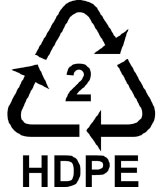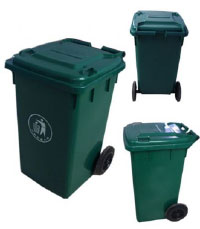LLDPE (Linear Low Density Polyethylene) LDPE and LLDPE have unique rheological or melt flow properties. LLDPE is less shear sensitive because of its narrower molecular weight distribution and shorter chain branching. During a shearing process, such as extrusion, LLDPE remains more viscous and, therefore, harder to process than an LDPE of equivalent melt index. The lower shear sensitivity of LLDPE allows for a faster stress relaxation of the polymer chains during extrusion, and, therefore, the physical properties are susceptible to changes in blow-up ratios. In melt extension, LLDPE has lower viscosity at all strain rates.
LDPE and LLDPE have unique rheological or melt flow properties. LLDPE is less shear sensitive because of its narrower molecular weight distribution and shorter chain branching. During a shearing process, such as extrusion, LLDPE remains more viscous and, therefore, harder to process than an LDPE of equivalent melt index. The lower shear sensitivity of LLDPE allows for a faster stress relaxation of the polymer chains during extrusion, and, therefore, the physical properties are susceptible to changes in blow-up ratios. In melt extension, LLDPE has lower viscosity at all strain rates.
This means it will not strain harden the way LDPE does when elongated. As the deformation rate of the polyethylene increases, LDPE demonstrates a dramatic rise in viscosity because of chain entanglement. This phenomenon is not observed with LLDPE because of the lack of long-chain branching in LLDPE allows the chains to slide by one another upon elongation without becoming entangled. This characteristic is important for film applications because LLDPE films can be down gauged easily while maintaining high strength and toughness. The rheological properties of LLDPE are summarized as "stiff in shear" and "soft in extension". It is not taken in most curb side pickups in communities. LLDPE can be recycled though into other things like trash can liners, lumber, landscaping ties, floor tiles, compost bins, and shipping envelopes
LLDPE has penetrated almost all traditional markets for polyethylene; it is used for plastic bags and sheets (where it allows using lower thickness than comparable LDPE), plastic wrap, stretch wrap, pouches, toys, covers, lids, pipes, buckets and containers, covering of cables, geomembranes, and mainly flexible tubing. In 2013, the world market for LLDPE reached a volume of $40 billion.
HDPE (High Density Polyethylene)
High-density polyethylene (HDPE) or polyethylene high-density (PEHD) is apolyethylene thermoplastic made from petroleum. With a high strength-to-density ratio, HDPE is used in the production of plastic bottles, corrosion-resistant piping,geomembranes, and plastic lumber.
 HDPE is known for its large strength-to-density ratio.[2] The density of HDPE can range from 0.93 to 0.97 g/cm3 or 970Kg/m3.[3] Although the density of HDPE is only marginally higher than that of low-density polyethylene, HDPE has little branching, giving it stronger intermolecular forces and tensile strength than LDPE. The difference in strength exceeds the difference in density, giving HDPE a higher specific strength. It is also harder and more opaque and can withstand somewhat higher temperatures (120 °C/ 248 °F for short periods, 110 °C /230 °F continuously). High-density polyethylene, unlike polypropylene, cannot withstand normally required autoclavingconditions. The lack of branching is ensured by an appropriate choice of catalyst (e.g., Ziegler-Natta catalysts) and reaction conditions.
HDPE is known for its large strength-to-density ratio.[2] The density of HDPE can range from 0.93 to 0.97 g/cm3 or 970Kg/m3.[3] Although the density of HDPE is only marginally higher than that of low-density polyethylene, HDPE has little branching, giving it stronger intermolecular forces and tensile strength than LDPE. The difference in strength exceeds the difference in density, giving HDPE a higher specific strength. It is also harder and more opaque and can withstand somewhat higher temperatures (120 °C/ 248 °F for short periods, 110 °C /230 °F continuously). High-density polyethylene, unlike polypropylene, cannot withstand normally required autoclavingconditions. The lack of branching is ensured by an appropriate choice of catalyst (e.g., Ziegler-Natta catalysts) and reaction conditions.
 APLICATIONS:
APLICATIONS:
HDPE is resistant to many different solvents and has a wide variety of applications:
• Swimming pool installation
• 3-D printer filament
• Arena Board (puck board)
• Backpacking frames
• Ballistic plates
• Banners
• Bottle caps
• Chemical-resistant piping
• Coax cable inner insulator
• Food storage containers
• Fuel tanks for vehicles
• Corrosion protection for steel pipelines
• Electrical and plumbing boxes
• Far-IR lenses
• Folding chairs and tables
• Geomembrane for hydraulic applications (such as canals and bank reinforcements) and chemical containment
• Geothermal heat transfer piping systems
• Heat-resistant firework mortars
• Hard hats
• Hula hoops
• Last for shoes
• Natural gas distribution pipe systems
• Fireworks
• Plastic bags
• Plastic bottles suitable both for recycling (such as milk jugs) or re-use
• Plastic lumber
• Plastic surgery (skeletal and facial reconstruction)[5]
• Root barrier
• Snowboard rails and boxes
• Stone paper
• Storage sheds
• Telecom ducts
• Water pipes for domestic water supply and agricultural processes
• Wood plastic composites (utilizing recycled polymers)



PP (Polypropylene Homopolymer) Polypropylene (PP), also known as polypropene, is athermoplastic polymer used in a wide variety of applications includingpackaging and labeling, textiles (e.g., ropes, thermal underwear and carpets), stationery, plastic parts and reusable containers of various types, laboratory equipment, loudspeakers, automotive components, and polymer banknotes. An addition polymer made from the monomer propylene, it is rugged and unusually resistant to many chemical solvents, bases and acids.
Polypropylene (PP), also known as polypropene, is athermoplastic polymer used in a wide variety of applications includingpackaging and labeling, textiles (e.g., ropes, thermal underwear and carpets), stationery, plastic parts and reusable containers of various types, laboratory equipment, loudspeakers, automotive components, and polymer banknotes. An addition polymer made from the monomer propylene, it is rugged and unusually resistant to many chemical solvents, bases and acids.


PVC ( Polyvinile Chloride)
White powder, it will appear different physical and mechanical properties after add various additives to it. It has better quality of mechanic feature, anticorrosion, dielectric and anti-chemicals.
PVC resin is the most widely raw material used in plastic production. It has good chemical stability, corrosion resistance and water resistance. It can be dissolved in acetone, hydrochloric ether, ester and some alcohol. It can offer good solubility, good electrical insulation, thermoplasticity and membrane forming capacity.
.
APLICATIONS:
PVC soft products It can be made of hoses, cables, wires, plastic sandals, shoes, slippers, toys, auto parts etc.
PVC film The transparent film can be used for greenhouses, plastic greenhouses and plastic film mulch. It can also be used for packaging bags, raincoat, table cloth, curtains, inflatable toys etc.
PVC coated products Can be used to make leather luggage, purses, book covers, sofa and car seat,etc. As well as floor covering, flooring materials for buildings.
PVC foam products
Can be used for foam slippers, sandals, insoles, and anti-vibration cushioning packaging material, Rigid PVC sheet and profiles, it is a new building material.
Can be used to make leather luggage, purses, book covers, sofa and car seat,etc. As well as floor covering, flooring materials for buildings.
PVC foam products
Can be used for foam slippers, sandals, insoles, and anti-vibration cushioning packaging material, Rigid PVC sheet and profiles, it is a new building material.